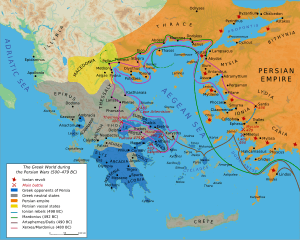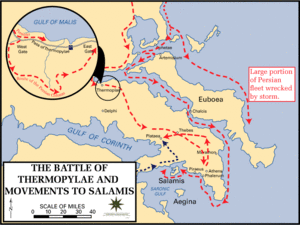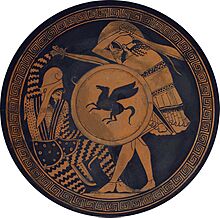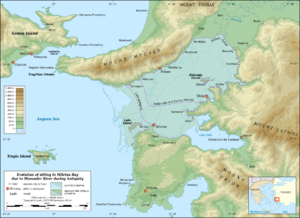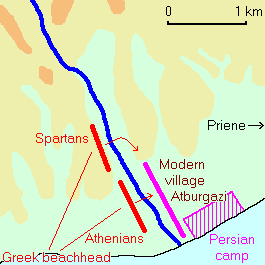Battle of Mycale facts for kids
Quick facts for kids Battle of Mycale |
|||||||||
|---|---|---|---|---|---|---|---|---|---|
| Part of the Second Persian invasion of Greece and the Greek counterattack | |||||||||
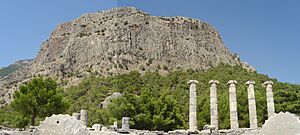 Part of Mount Mycale, viewed from the ruins of Priene |
|||||||||
|
|||||||||
| Belligerents | |||||||||
| Greek city-states | Achaemenid Empire | ||||||||
| Commanders and leaders | |||||||||
| Leotychides Xanthippus Perilaus † |
Artaÿntes Masistes Ithamitres Mardontes † Tigranes † |
||||||||
| Strength | |||||||||
| 40,000 men, 110-250 ships |
60,000 men, 300 ships |
||||||||
| Casualties and losses | |||||||||
| Considerable | Most of the army and all the ships | ||||||||
The Battle of Mycale was a huge fight that helped end the Second Persian invasion of Greece. It happened around August 27, 479 BC. This battle took place on the slopes of Mount Mycale in Ionia, which is now part of Turkey. It was fought between an alliance of Greek city-states (like Sparta, Athens, and Corinth) and the powerful Persian Empire, led by Xerxes I. This victory was a major turning point in the Greco-Persian Wars.
Contents
Why the Battle of Mycale Happened
The Persian Invasion Begins
The Greco-Persian Wars started because some Greek cities, like Athens, supported a revolt against the Persian Empire. The Persian King Darius I wanted to punish these cities. His son, Xerxes I, continued this goal.
In 480 BC, Xerxes led a massive Persian army and navy to invade Greece. They won battles at Thermopylae and Artemisium. They even captured Athens. However, the Greek navy won a huge victory at the Battle of Salamis. This stopped the Persians from conquering southern Greece.
Persian Retreat and Greek Plans
After the loss at Salamis, Xerxes went back to Asia. He left his general, Mardonius, with a large army to finish the invasion. The Greeks, meanwhile, formed an alliance. They decided to fight Mardonius on land.
In the summer of 479 BC, the Greek army marched to face Mardonius at the Battle of Plataea. At the same time, the Greek navy sailed to Samos. The Persian navy, which had been badly beaten at Salamis, was hiding there.
Persians Avoid a Sea Battle
The Persians did not want another naval battle. They moved their ships from Samos to the coast near Mount Mycale. There, they pulled their ships onto the land. They built a strong wooden fence, called a palisade, around them. This created a makeshift fort to protect their ships and army.
The Greek commander, Leotychides, decided to attack them anyway. He landed his soldiers, called marines, from the ships. They were ready to fight on land.
Who Fought at Mycale?
The Persian Forces
Historians aren't exactly sure how many soldiers and ships the Persians had. Some say there were about 60,000 men in their army at Mycale. They had pulled around 300 ships onto the beach. The Persian army included soldiers from different parts of their empire. They had spearmen and archers.
Some Greek soldiers were fighting for the Persians. But, during the battle, many of these Greek mercenaries switched sides. They joined the Allied Greek forces.
The Greek Forces
The Allied Greek fleet had between 110 and 250 ships, called triremes. A trireme was a fast warship powered by rowers. Each ship carried about 14 to 45 heavily armored soldiers, known as marines or hoplites. Hoplites were Greek citizen-soldiers. They were famous for their strong armor and fighting skills.
Overall, the Greeks probably had around 40,000 men, mostly rowers and marines. Only the marines were trained and equipped to fight in a land battle.
The Battle Unfolds
Approaching the Enemy
When the Greeks arrived at Mycale, the Persians stayed inside their fortified camp. Leotychides, the Greek commander, sailed close to the shore. He sent a message to the Ionian Greeks who were forced to fight for Persia. He told them to remember their freedom and to fight for the Allied Greeks. This message was meant to make the Ionians switch sides or make the Persians mistrust them.
The Persians, suspecting the Ionians, took away their weapons. They also sent the soldiers from Miletus to guard mountain passes. This was to prevent them from joining the Greeks. But this also weakened the Persian army.
The Fight Begins
The Greeks landed their troops and prepared to attack the Persian camp. They formed two groups. The right side, with Athenians and Corinthians, marched straight towards the camp. The left side, with the Spartans, went through rougher ground to try and surround the Persians.
The right wing of the Greek army started fighting first. The Persians fought bravely at the beginning. But the Athenians and their allies pushed hard. They wanted to win before the Spartans arrived.
Greek Victory
Eventually, the Persians broke and ran back to their palisade. The Greek soldiers followed them into the camp. Many Persian soldiers fled, but the main Persian troops fought fiercely inside the camp.
Finally, the Spartan left wing arrived. They attacked the remaining Persian forces from behind. This completed the rout, meaning the Persians were completely defeated.
During the battle, the disarmed Samians (Ionian Greeks) joined the Allied Greeks. They helped as much as they could. Other Ionian groups also turned against the Persians. Even the Milesians, who were supposed to guard the passes, started killing the fleeing Persians.
Many soldiers died on both sides. The Persian admiral Mardontes and general Tigranes were killed. A few Persian soldiers managed to escape to Sardis.
What Happened After Mycale?
The End of the Invasion
The Greek soldiers looted the Persian camp and burned their ships. The victories at Mycale and Plataea, which happened on the same day, ended the second Persian invasion of Greece. The threat of Persia conquering Greece was largely over.
The Greeks then sailed to the Hellespont to destroy the Persian pontoon bridges. But they found the bridges were already gone. The Spartans went home, but the Athenians stayed. They attacked the Chersonesos, a region still held by the Persians. They laid siege to the city of Sestos, which eventually fell to the Athenians. This marked the start of the Greek counterattack.
Over the next 30 years, the Greeks, especially the Delian League led by Athens, pushed the Persians out of many areas. Finally, in 449 BC, a peace treaty was signed, ending the long wars.
Why Mycale Was Important
The Battle of Mycale, along with the Battle of Plataea, was incredibly important. These battles decisively ended the Persian invasion. They shifted the power balance in favor of the Greeks. While battles like Thermopylae and Salamis are more famous, Mycale and Plataea truly secured Greece's freedom.
Militarily, Mycale showed once again that the Greek hoplites were superior fighters. Their heavy armor and training made them very effective against the lighter-armed Persian infantry. After these wars, the Persian Empire even started hiring Greek mercenaries because they recognized their fighting skills.
See also
- Battle of Plataea
- Battle of Salamis
- Delian League
- Greco-Persian Wars
- Leotychides
- Second Persian invasion of Greece
- Xanthippus


